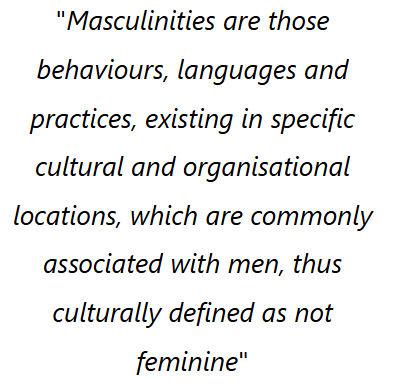What is Masculinity?
Definition : Masculinity involves displaying attitudes and behaviours that signify and validate maleness, and involves being recognised in particular ways by other men and women.
Society : Masculinity
There is no universal set of expectations around masculinity: within societies, there are dominant codes that exert pressure on, and create expectations around men – with consequences for women, children and society as a whole.

The understanding of masculinity varies across time and socio-cultural contexts, and within groups and networks; and men also ‘perform’ their masculinity differently and inconsistently. Just as masculinity is defined by its relationship with femininity, women too have an important role to play in the interpretation and understanding of masculinity, particularly in their interaction with men and boys.
Different studies acknowledge four facets of masculinity: hegemonic, complicit, marginalized, and subordinate masculinities
Hegemonic Masculinity
This refers to the dominant, culturally idealized form of masculinity, which emphasizes traits like strength, toughness, independence, and risk-taking behaviour., men who adhered to hegemonic masculinity were more likely to engage in harmful behaviours like excessive alcohol consumption and smoking, as these actions were seen as ways to affirm their masculinity. They often re direct the responsibility for their health to women, as the preparation of food, in particular, was perceived as a feminine duty. However, hegemonic masculinity also had protective elements. Moreover , men who followed this ideal were more likely to engage in physical activity to maintain physical strength and muscle mass, which is linked to better health outcomes.

Complicit Masculinity
This group refers to men who may not fully embody hegemonic masculinity but still benefit from the social privileges that come with the dominant gender norms. They may not actively engage in all of the behaviours associated with hegemonic masculinity, but they are still complicit in the broader system that privileges these traits. In terms of health, men with complicit masculinity might not engage as heavily in risk-taking behaviours like drinking or smoking, but they may still hold some of the traditional views about food preparation and health that could affect their choices.

Marginalized Masculinity
This form of masculinity is associated with men who are marginalized due to factors such as race, class, or socioeconomic status. These men may struggle to meet the idealized standards of hegemonic masculinity. While the study didn’t focus extensively on marginalized masculinity, it’s possible that men who fall into this category might face additional challenges when it comes to health behaviours. For example, they may experience greater barriers to accessing healthcare, nutritious food, or opportunities for physical activity, which could make it more difficult to adhere to healthy lifestyle practices.

Subordinate Masculinity
Subordinate masculinity refers to men who deviate from or do not conform to the traditional masculine ideals. These men are often looked down upon by those who adhere to hegemonic masculinity. This could include men who are less physically competitive or who do not engage in behaviours like heavy drinking. In the context of the study, subordinate masculinity might align with men who are more willing to take responsibility for their health, particularly around food preparation or seeking medical care. However, the study suggests that these men might still struggle with societal expectations and gender roles that discourage healthy behaviours, particularly when it comes to being the primary caregivers or decision-makers regarding health.

Femininity
Femininity (also called womanliness) is a set of attributes, behaviours, and roles generally associated with women and girls. Femininity can be understood as socially constructed, and there is also some evidence that some behaviours considered feminine are influenced by both cultural factors and biological factors.
Identity
Identity is the set of qualities, beliefs, personality traits, appearance, and/or expressions that characterize a person or a group. Identity emerges during childhood as children start to comprehend their self-concept, and it remains a consistent aspect throughout different stages of life
How identity can be influenced by “place”, or belonging, your environment or upbringing.
There are many factors that shape identity, and they can be both external and internal factors. Society, family, friends, ethnicity, culture, location, media, interests, self-expression, and life experiences are all common factors that shape identity.
Multiple pathways exist through which families may influence adult identity formation, including levels of social control and monitoring, warmth and closeness, responsibility, and hierarchical family relations
When we are in familiar surroundings, we tend to feel more secure and strengthen our sense of identity. We feel more in control of our lives and boost our self-confidence. On the other hand, when we lack an established place, a home, we may feel lost and disconnected.
“Placefulness” is an awareness of the place—where one is or where one comes from. And remembering that places shape one’s expectations and understandings of the world. Feeling a sense of belonging is very important. Without it, we’re unmoored in the world.but it can also lead to a lack of awareness.
Our sense of identity and belonging is impacted by various factors, including our experiences, relationships, and our environment. The journey to find identity and belonging can often be a struggle, since we ask ourselves, ‘who am I?

